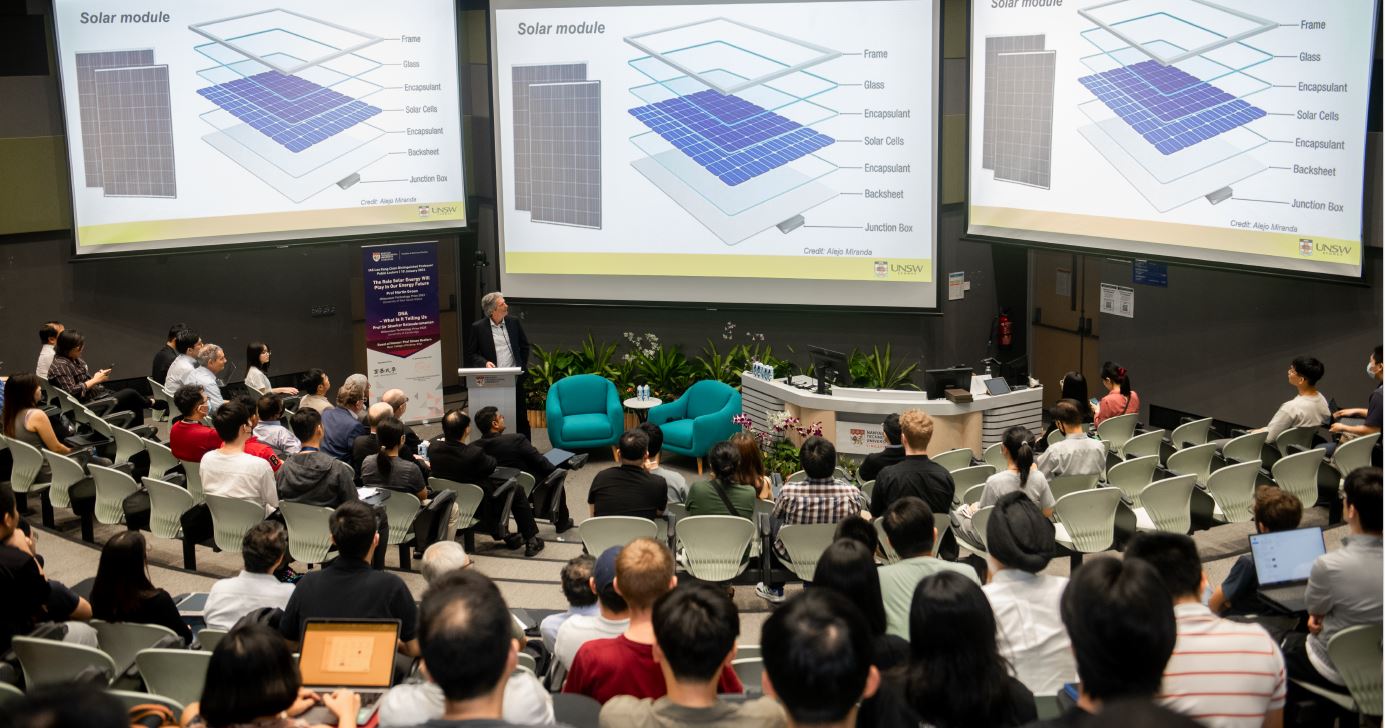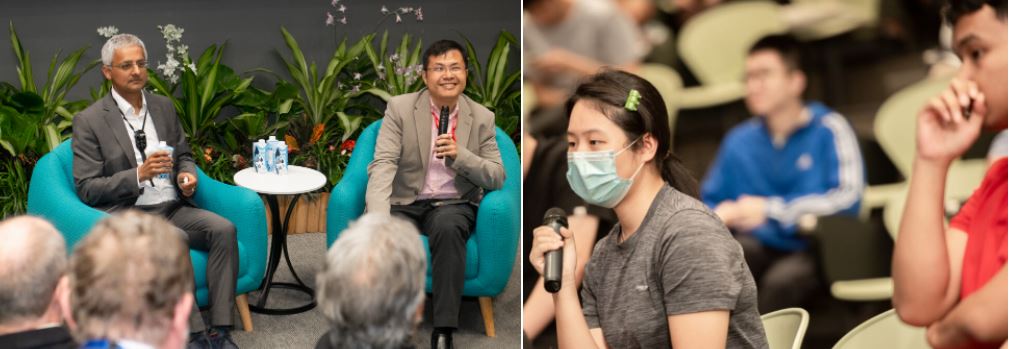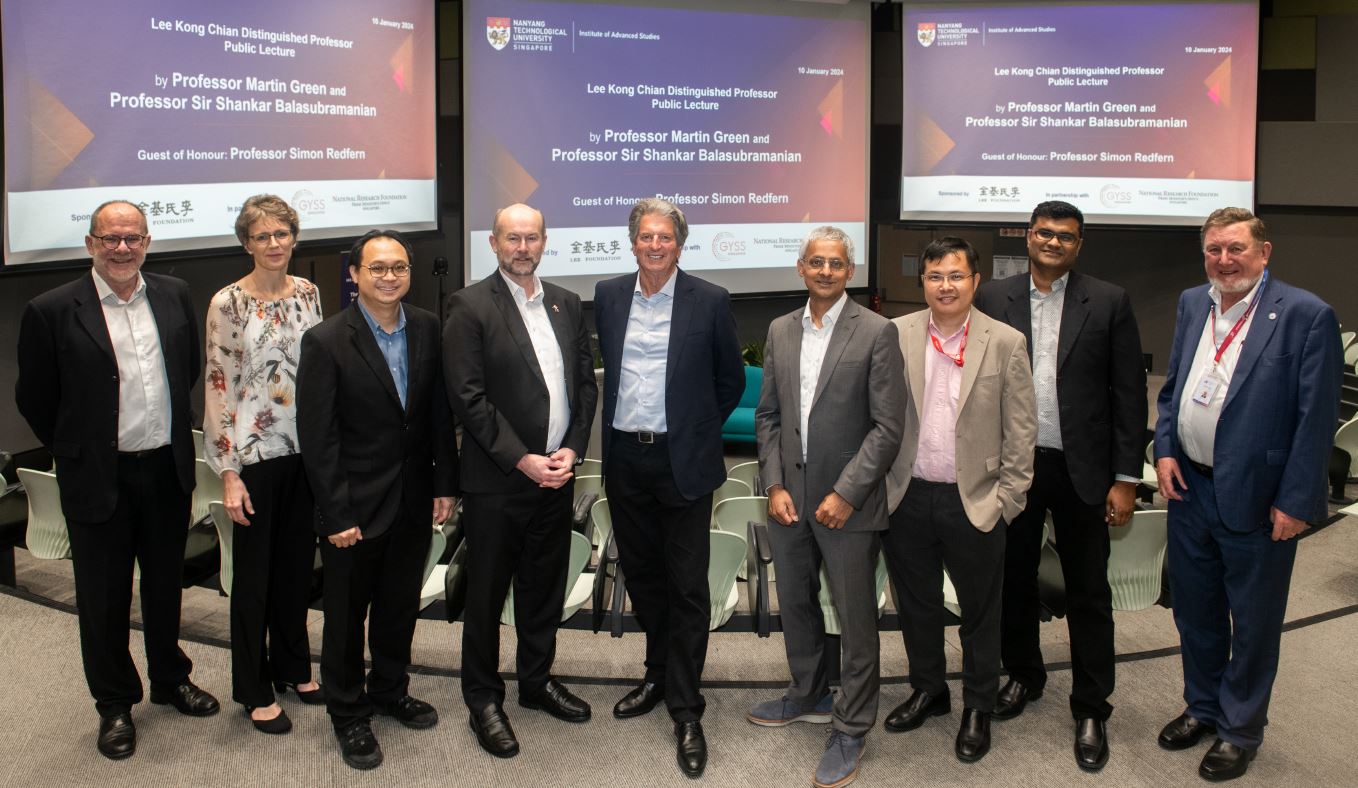Lee Kong Chian Distinguished Professor Public Lecture by Millennium Technology Prize Laureates
Dr Alvin Ng Wei Tian | Presidential Postdoctoral Fellow, Lee Kong Chian School of Medicine, NTU
Sponsored by Lee Foundation, the public lecture was held as a partner event of the Global Young Scientists Summit 2024 organised by the Singapore National Research Foundation. Held on 10 January 2024 at the Tan Chin Tuan Lecture Theatre, the event featured two esteemed speakers: Prof Martin Green (Millennium Technology Prize laureate 2022) and Prof Sir Shankar Balasubramanian (Millennium Technology Prize laureate 2020). Assoc Prof Nripan Mathews, Associate Director of IAS, delivered a welcome address, followed by opening remarks from Prof Simon Redfern, Dean of the College of Science at NTU.
Prof Martin Green brought us on a journey from the past and present to the future of photovoltaics during his stellar talk titled "The Role Solar Energy will play in our Energy Future". Starting from an atomic level, he discussed the fundamental physics of how solar energy is converted to electric energy and the evolution in technologies and key hallmarks that contributed to the high uptake of solar panels today.
 Prof Martin Green's engaging talk on solar energy.
Prof Martin Green's engaging talk on solar energy.
The journey started all the way back in 1953 when the first photovoltaic cells were made and the promise of solar power to revolutionise our daily lives was perceived. What was unexpected were the number of years and breakthroughs needed to improve the technology and decrease the costs. An impending climate crisis also helped to speed up the process. Prof Green was at the forefront of photovoltaic research since 1974 and developed solar cells that were the most efficient at that time. Notably, his technology eventually accounts for more than 90% of solar cells used today. Numerous scientists have worked to continuously improve the energy conversion efficiency of solar cells, and this trend shows no sign of slowing down even today.
During Prof Green’s illustrious career in photovoltaics, he mentored more than 120 students who later took up important roles in the wide adoption of solar power technology worldwide. Most prominently, his 12th PhD student played a role in developing technology to improve the manufacturing of solar cells that immensely reduced the cost of production and became a key factor in the adoption of solar power.
The talk offered a glimpse into a future where solar power plays a pivotal role in mitigating carbon emissions and producing clean energy. The widespread adoption of solar technology is a potent tool in addressing climate change, and the ongoing advancements, particularly in more efficient and cost-effective solar cells, are poised to amplify its impact. It is not too far-fetched to think that the same technology that took decades to come to fruition will be far more commonplace in the decades to come. Prof Green's public lecture has indeed provided us with valuable insights to contemplate for the future.

(Left) Q&A session with Prof Martin Green, moderated by Assoc Prof Nripan Mathews. [Right] Prof Simon Redfern presenting memento to Prof Martin Green.
Following Prof Green's insightful session, Prof Sir Shankar Balasubramaniam’s gave a talk titled "DNA - what is it telling us?". He inspired us with his story how he and Prof David Klenerman discovered a new way to read the DNA molecular code at a scale and speed orders of magnitude higher than previously done. Their work revolutionised biology research and the understanding of genetic diseases by making DNA sequencing a tool in every biologist’s toolbox, thereby accelerating diverse fields of research.

Prof Sir Shankar sharing his groundbreaking DNA sequencing journey.
The Solexa technology that Sir Shankar and Prof Klenerman invented stemmed from a fundamental experiment in 1997 aimed at observing the synthesis of DNA by an enzyme that polymerises the building blocks of DNA. Through an intricate re-design of the building blocks and a combination of cutting-edge lasers, cameras, and chemistry, the first Solexa sequencer was born. With the first sequencer, they could read genomes in a massively parallel way. Remarkably, the first human genome that took more than a decade to decipher previously can now can be sequenced within a few days. Today, this breakthrough allows us to read multiple genomes from a population and appreciate the genetic differences between individuals.
Sequencing at a population scale is here and now. Population sequencing projects in the United Kingdom, United States and even in Singapore are enabled by the same technologies developed by Sir Shankar's team, and later bought over by Illumina. We are only at the start of large-scale population sequencing projects to understand genetic variation between individuals, which will deepen our knowledge of human genetics.
The applications of sequencing expand beyond studying human genomes to all species including endangered animals. Being able to read and understand what DNA is telling us has brought on the era of personalised genomics and medicine. Doctors can tailor treatments based on specific mutations in a tumour. Moreover, patterns in the mutations can also shed light on how a tumour develops. One application of sequencing relies on the fact that tumor cells release fragments of DNA into the bloodstream. A UK clinical trial is currently assessing the sequencing's capability to identify these circulating DNA fragments. In the near future, detecting the presence of a tumor could potentially be as simple as sequencing a vial of blood at a local clinic.
 Lively exchange of ideas during the Q&A with Sir Shankar, moderated by Assoc Prof Tan Meng How (CCEB, NTU).
Lively exchange of ideas during the Q&A with Sir Shankar, moderated by Assoc Prof Tan Meng How (CCEB, NTU).
Understanding what DNA is telling us has come a long way since the first human genome in 2003 that cost more than a billion dollars. With the groundbreaking work of Sir Shankar's team on next-generation sequencing, we are at the dawn of a new era in biology and medicine where we can truly understand and treat disease based on each individual's genome.
 (From left) Prof Simon Redfern, Ms Wanda Preiser (Office of International Engagement, NTU), Prof Sum Tze-Chien, His Excellency Allaster Cox (Australian High Commissioner to Singapore) , Prof Martin Green, Prof Sir Shankar Balasubramanian, Assoc Prof Tan Meng How, Assoc Prof Nripan Mathews and Prof Richard Parker (Special Advisor, A*STAR).
(From left) Prof Simon Redfern, Ms Wanda Preiser (Office of International Engagement, NTU), Prof Sum Tze-Chien, His Excellency Allaster Cox (Australian High Commissioner to Singapore) , Prof Martin Green, Prof Sir Shankar Balasubramanian, Assoc Prof Tan Meng How, Assoc Prof Nripan Mathews and Prof Richard Parker (Special Advisor, A*STAR).
"I enjoyed learning about the speakers' journeys and their unique insight into their inspiring achievements."- Oh Sher Li (PhD student, IGP-Neuroscience NTU)
"Sir Shankar really made us feel as though we were with him throughout his journey of developing his ideas."- Veronica Pereira (PhD student, CCEB NTU)
"I gained knowledge beyond my major."- Sun Haonan (PhD student, GC-IGP NTU)







